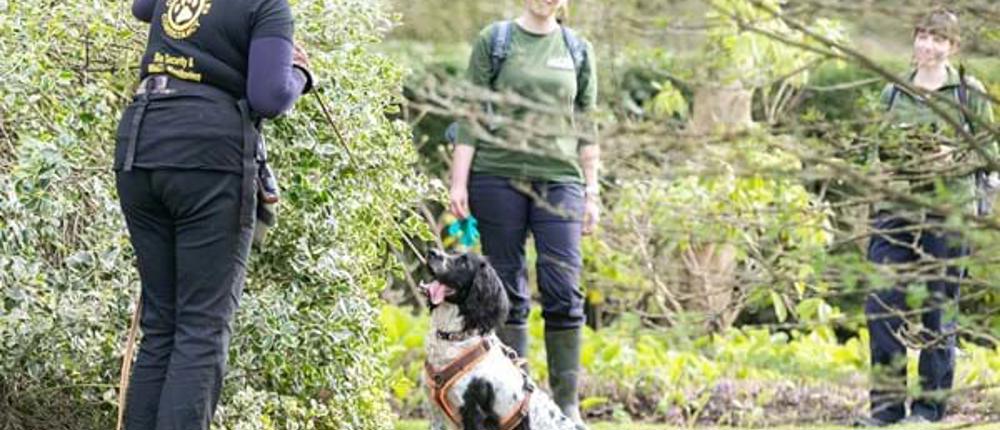Dr Lucy Bearman-Brown, Senior Lecturer in Animal Science at Hartpury University, recently appeared on The One Show in a feature about how she is helping to train a detection dog called Henry to sniff out hedgehogs safely for conservation purposes.
In the following blog, she provides advice about how people can help and support hedgehogs in their garden, as part of Hedgehog Awareness Week.
Over the last year, with repeated lockdowns, many of us have had more time at home than usual, giving opportunities to turn our hands to tasks we may not have even realised needed doing, like fixing holes in the garden fence, clearing corners full of weeds, or ridding the veg garden of pesky snails.
But what if all those jobs could be left, as a way of helping out some prickly pals?
Hedgehogs are in decline across Europe – by 50% decrease over the last 10 years in open countryside, and by about 30% in urban areas.
In towns and villages up and down the country they are making a comeback, though, ever so slightly.
This could be due to a number of reasons, including the wildlife havens many nature loving folk make their gardens into, protecting them from predators such as badgers, whilst providing ample food and nesting places.
So how can you turn your garden into such a refuge for our prickly friends?
Firstly, allow them into your garden. Make a hole, about 13cm in diameter, in fences – ideally on all sides of your garden– so hedgehogs can easily move around the neighbourhood.
Research has shown they can visit up to 10 gardens and walk several kilometres a night!
Ask your neighbours (in a socially distancing way, of course) to do the same, so as many gardens are connected as possible.
Secondly, avoid injuries to hedgehogs that have arrived in your garden. When clearing areas of long grass or mowing the lawn, check the area carefully before you start work.
Hedgehogs nest in long grass or dried leaf litter, and can be surprisingly well camouflaged.
During research here at Hartpury we estimated over 60,000 hedgehogs a year go to wildlife hospitals, many of which are because of garden injuries, including from strimmers, garden forks and bonfires.
As hedgehogs will soon give birth to hoglets, it’s a particularly sensitive time as females may abandon them if nests are disturbed.
Next is making your garden a safe haven, so leave pruning those bushes, clearing that ivy and pulling up those weeds.
Wildlife needs shelter, so mature planting is helpful. Creating places to hide allows hedgehogs to build nests, where they spend their days, before venturing out at night to forage.
Gaps under sheds and decks, compost heaps, quiet leaf strewn corners, log piles and artificial hedgehog houses can all provide much needed hideaways.
In a recent study at Hartpury we found hedgehogs can build new nests every day or so, so the more options the better!
Number four on the list is food and water. A dish of water in several places around the garden will be appreciated by all wildlife, especially as the good weather has arrived, it seems.
Providing a feeding station can help encourage hedgehogs into your garden too. Cat biscuits, tinned cat or dog food or specialist hedgehog food (available from garden centres and pet shops) all make suitable nourishment.
If you’re worried that the neighbourhood cats will demolish everything before the hedgehogs get a look in, you could turn a plastic storage tub into a hedgehog restaurant.
There are many resources on the internet for how to do this. If you set up your feeding station within sight of the house, you may be lucky enough to see a visitor polishing off your provisions!
The final step on the road to a hedgehog haven is encouraging natural food.
Whilst few humans are a fan of slugs and snails, hedgehogs are… along with earthworms, beetles, caterpillars, earwigs and millipedes.
Whilst hedgehogs are largely insectivores, they are generalists too, so have been recorded eating frogs, baby rodents, fallen bird eggs and chicks, fallen fruit and carrion.
Poisons used to control rats, slugs and other unwanted visitors can be readily eaten by a hungry ‘hog, so the key to protecting them is to not use these chemicals in your garden.
If you are lucky enough to have hedgehogs visit your garden, make sure they want to keep coming back, so keep disturbance to a minimum.
Watch from the house, or a quiet corner and don’t approach them or handle them as they are rather shy. They’re very friendly though, which may be a good reason why they are Britain’s favourite – and mine.
To learn more, why not visit www.hedgehogstreet.org to register as a hedgehog champion!
Picture: Dr Lucy Bearman-Brown (background) with detection dog Henry and his trainer Louise Wilson at Hartpury








